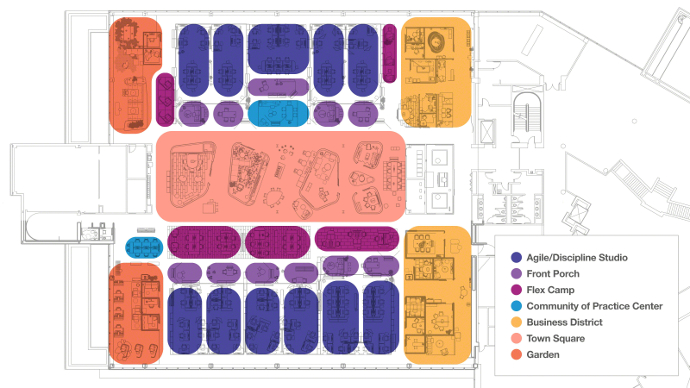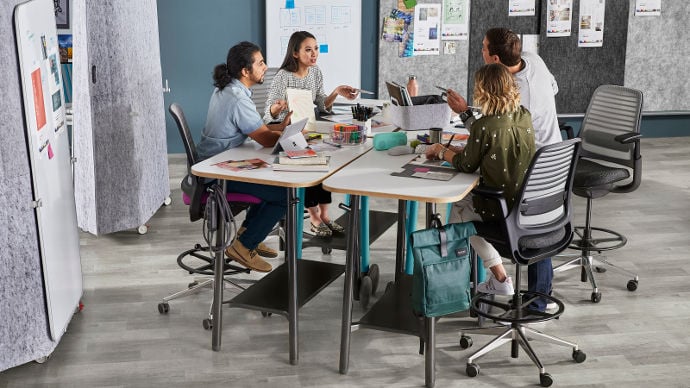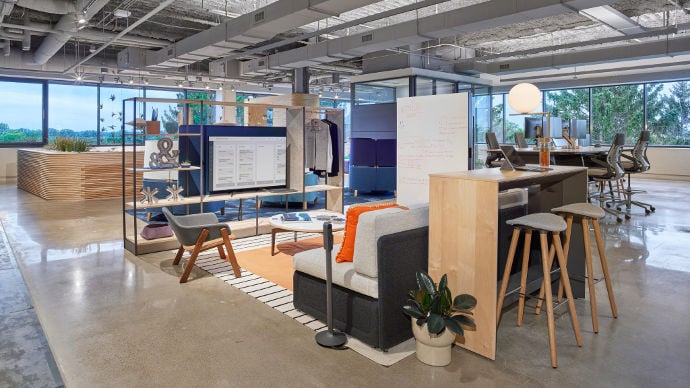With the coronavirus vaccine being rolled out, organisations are starting to think about what the office needs to look like to meet the needs of their employees in a post-covid world.
The workplace doesn’t just need to look good to attract and retain talent. More importantly, the space needs to work for the employees; to suit the ways they want to work, to enhance productivity, and to provide comfort, security and inspiration.
Office space planning is a key element of the design process, because it focuses on organising the space, furniture and functions to work together to meet the needs of the people who use it.
Here, we explore the importance of space planning in creating a workplace that allows individuals and teams to thrive, and what impact the pandemic may have on your existing space plan.
Office space planning - the basics
Office space planning is the process of designing how people will use the space.
Office space planning involves an in-depth analysis of how the space is to be used and then creating a plan that designs the zones of the space and the activities that will take place within them.
The space plan will determine the circulation patterns that show how people will move through the space. The placement of furniture, equipment and hardware is also considered to make the most of the space and facilitate the activities within each zone.
There are a number of benefits of office space planning, including:
- It allows for synergy between people, place and technology
- It provides people with the spaces, furniture and equipment they need to work effectively
- It helps organisations make the most of their floor space and reduce rental costs
- It allows for spaces to be adapted to support growing teams
Here's an example of how a workplace has been designed to support different activities:

How to plan office space effectively
Office space planning should start with defining your needs.
First, think about your goals as an organisation. Are you looking to boost employee engagement? Or focused on improving productivity? Do you want to encourage more collaboration and agile working? Or is your priority providing people with quiet, private spaces for high-concentration work?
The modern office requires an ecosystem of spaces that allow people to move between different modes of working.
In this ecosystem of spaces, workers should be free to find the working environment that suits them best for each task they are required to perform.
Focused work - Workplaces need quiet spaces for individuals to perform high-concentration tasks. Enclosed spaces such as pods and booths, or the use of screens and barriers, can give people the peace and privacy they need to focus.
Collaboration - The modern workplace needs spaces for people to come together and work on projects. These collaborative spaces require moveable furniture so teams can reconfigure the space on their own to suit work flows and changes throughout the project. Furniture should also encourage movement, as research shows people are more energised when they take up standing positions. Likewise, stools and high tables bring people closer together to sharpen their focus.

Socialisation - Communal spaces such as the work cafe, foyer and atria allow for people to come together to socialise and connect. The ability to connect with others is one of the top things people have missed about being in the office while working from home during the pandemic. In the future, social spaces are going to be important for encouraging people to come into the office.
Relaxation - Calm, contemplative spaces provide a haven for workers to relax and destress, so they can come back to work refuelled and better able to focus. These spaces could include pods, booths or larger no-tech zones, fitted with furniture that aids lounging and relaxation.
Space planning also involves understanding how different spaces need to interact with each other. There are a variety of ways spaces can be related to each other:
- A space within a space
- Spaces linked by a communal space
- Interlocking spaces
- Adjacent spaces
Consider how often people will need to move from one space to another, and what that experience needs to be like. For example, if teams are constantly shifting from collaborative to focused work, a space within a space format might be best suited. This will allow for people to do individual work in quiet pods or workstations with varying levels of privacy around a collaborative zone where they can come together to share and build on ideas.
The advantage of such a set up is that when working individually, people still feel like part of a team. Ultimately, the best collaborative spaces are designed for what the team needs to do together, whilst simultaneously recognising the ‘me’ within ‘we’.

These collaborative spaces will also need to be positioned away from high traffic areas so teams aren’t constantly interrupted by people coming and going.
Office space planning in a post-covid world
“Coming together in the workplace to socialize and collaborate will become the greatest purpose that the new office can fulfill.” Steelcase
Over the past year, people’s working habits have changed. Being at home has allowed people to discover the working patterns and solutions that work best for them, and this greater degree of autonomy and flexibility will cross over into how they use the office in the future.
Firms will need to go back to basics and ask themselves - what do your employees need from the workspace? How well does your existing space support those needs? And what do you need to change to make it work better for their needs?
The office will remain an important source of human connection, and the post-covid office needs to be designed with this in mind. Perhaps you’ll need more collaborative spaces and fewer desks.
Although the vaccine is being rolled out, people may still be concerned about safety. Adding new elements to the space to help physical distancing feel more comfortable, such as adding glass or higher screens to workstations, may be important for helping people to feel safe.
We may be working our way out of the current crisis, but organisations need to be prepared for new waves of the virus or future pandemics. Workplaces that can support both greater and less social distancing as the need arises will be better equipped to face future disruptions.
Steelcase highlighted three main design challenges in a post-covid world that will need to be considered:
Physical distancing - enabling individuals to maintain 2m distance from each other (furniture arrangement also needs to provide adequate distancing)
Circulation patterns - people must be able to move through spaces while maintaining their personal space
Spatial context - understanding your spatial context is required to adapt and design shared spaces to solve for physical distancing and circulation patterns
“Understanding distancing and density, and their relationship to circulation patterns within an existing spatial context, is key to solving for the evolving safety guidelines in shared spaces.” Steelcase
In the work cafe, for example, you can reduce density by shifting away from large communal tables and towards arranging seating in smaller groups. Adding screens and biophilic elements will help define boundaries and provide psychological comfort.
-1.jpg?width=690&name=20-0140881%20(1)-1.jpg)
What is certain, is that in a post-covid world, the office as a space for collaboration and socialisation will become more important than ever. People may choose to come into the office three days a week for project work and spend two days a week at home and away from distractions to focus on high-concentration work.
Space planning and focusing on supporting the way people want to use the workplace will be critical for creating inviting and compelling spaces that people want to be in.










